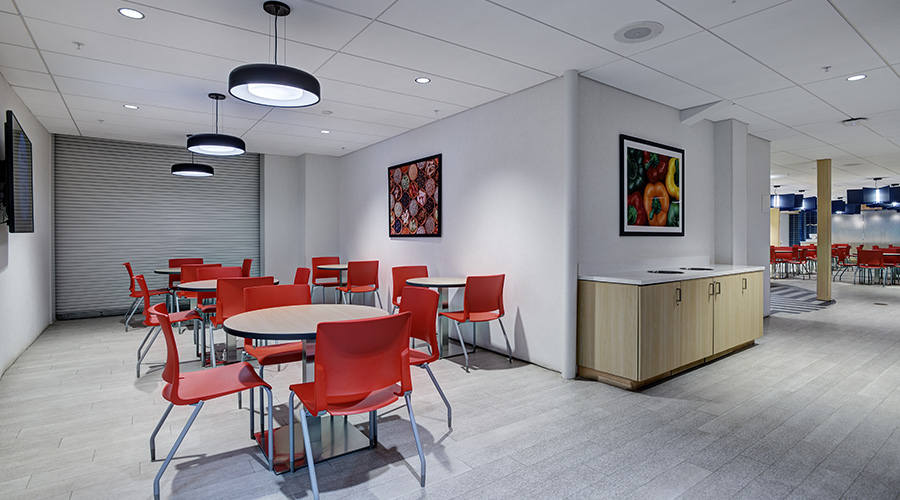Remedies for Rapid Growth
Maintenance at Northeast Medical Center lays out strategies for keeping pace with its facilities’ aggressive expansion
To meet the needs of a growing and aging population and to survive in a highly competitive business, health care organizations across the country are expanding their facilities. Over the past several years, the facilities management services department at NorthEast Medical Center in Concord, N.C., has been dealing with one inevitable result of such expansion — the growing maintenance and engineering challenges associated with constant facility expansion and renovation projects. Keeping pace with these infrastructure upgrades while maintaining existing portions of the facility is a difficult balancing act.
“We always have a lot of construction and renovation projects going on at the same time,” says Philip Stephens, director of facility management services (FMS) at the medical center. “We’re constantly challenging the facilities department because we are trying to maintain the buildings and, at the same time, assist the contractors with the numerous shutdowns that have to occur as new equipment is tied into existing systems.”
The medical center is adding two floors to its clinical services building, expanding its cardiology and oncology building, and constructing an adjacent parking deck.
When completed, these projects will add about 218,000 square feet of building space to the medical center’s main campus, which sits on about 67 acres.
Shutdown Strategies
Coordinating system shutdowns to prevent interference with the daily operations of building occupants is one of the most challenging tasks Stephens’ department faces.
“If we need to shut down the oxygen supply because we’re adding to the oxygen systems, we have to coordinate that shutdown with the surgery and labor and delivery department, as well as with all the patient rooms throughout the hospital that have patients on oxygen,” Stephens says.
Adds Tony Rary, the medical center’s facilities manager, “As a general rule, we require 72-hour notice before any shutdowns. If it is a minor shutdown that affects minimal people and does not directly affect patients, we sometimes will fudge on the 72 hours, but generally, we do not.”
Once contractors request a shutdown, the next step is for an in-house technician to walk through the area with the construction supervisor to see what the shutoff entails, says Carl Walker, the medical center’s lead HVAC mechanic. The contractor estimates how long the construction crew needs the shutoff to last to complete the work, and the facilities management services department determines the impact of the shutoff on patients, visitors and guests.
The department decides when would be the best time to conduct the shutdown.
The contractors, “might want to do the shutdown at a certain time, and we would tell them no because it might affect surgical areas or areas that are really busy during the day,” Stephens says. In these cases, the shutdowns often take place at night or on weekends.
In the case of the clinical building expansion, the contractors recently poured concrete for the two-floor addition at 2 a.m.
“While it probably wasn’t the most convenient time to bring in concrete contractors, it worked out better for our logistics around the campus area,” Rary says. These projects often require in-house staff to adjust their work schedules.
“Generally, there is always someone here from the FMS department during a shutdown,” Rary says. “We do not let the contractors come in without one of us being here.” The department relies on backup oxygen systems and emergency generators to ensure critical systems continue operating.
“In some instances, like our computer room, we’ll bring a mobile cooling unit in to keep that area cool so the computers keep running,” Walker says.
The department also finds ways to minimize the duration and impact of shutdowns, which generally last no more than two hours.
For example, technicians might shut an air handler down for up to an hour to remove a piece of ductwork and isolate it or block it off, then bring the system back up, Walker says. Contractors then can work on the portion of the system blocked off.
Communication Considerations
Not all of the medical center’s 4,100 employees have a mailbox or regularly use a computer. So it can be difficult for the organization to notify everybody of system shutdowns before they occur.
“That is one of the hardest parts of the projects — not actually doing the work, but making sure the people know what is happening,” Walker says. The department works with the medical center’s communications department to notify staff members stationed in areas affected by the shutdowns.
“We need to make sure that everybody is prepared,” Rary says. “Inevitably, there will be one or two people who will say they didn’t know anything about it. Even though we put out the word in every way conceivable, somebody will miss it.”
After shutting down a system, the department inspects the affected areas one final time and confirms that it doesn’t interrupt the the hospital’s critical operations before allowing the contractors to begin their work.
“We do this in case the department has to stop the shutdown, before the work gets to far along,” Rary says.
Troubleshooting
When facility expansions occur, the facility management services department also works with contractors to ensure newly installed technology is compatible with the existing infrastructure, which can be challenging.
“The best engineering efforts do not always foresee some of the problems that will occur when you bring the systems online,” Stephens says. For example, imbalances might exist in air-delivery or water systems.
“There is really only so much planning that you can do for that,” he says. “The engineers designing the building predict as much of it as they can, but there’s always that unknown when these systems start coming online.” Sometimes, problems are not easy to correct.
“A problem might cause us to go back and redesign and upgrade existing systems when we weren’t planning to because we cannot easily deal with the imbalances,” he says.
Renovation projects can be more challenging than expansions, especially if the area to be renovated must meet requirements not foreseen by original design. For example, a few years ago, the hospital decided to renovate its old radiology and emergency department areas into a laboratory.
“The requirements for the laboratory in terms of heating, air conditioning and water were so much different than they were for the old radiology and emergency departments,” Stephens says. Those new requirements change the configuration of the overall existing support systems. These situations create the imbalances sometimes, Stephens says. Sometimes, balancing systems takes days, but in other cases can takes weeks or months.
When problems occur, the architects and engineers will handle the specifics, but the facility management services department performs the actual testing and adjusts the systems after the project is complete. Often, the new systems operate but fail to meet the department’s performance expectations.
Because of such situations, organizations budgeting for expansion and renovation projects should account for more than just the cost of the project itself, Stephens says. They also will need to budget for needed changes to existing systems to allow them to support the added infrastructure. Many organizations fail to budget for these situations initially.
“It really needs to be done because the problems are not going to go away,” he says. “Sooner or later, they are going to have to fix them because the hospital is not going to operate correctly. So it’s either pay for it now or pay for it later.” Even after the systems are compatible, the work to maximize their efficiency is not complete.
“We always tweak the system to make it works at its maximum,” Stephens says. That process is ongoing as the department continually looks for ways to make the systems more energy efficient. To help us, we have a pretty sophisticated system that lets us monitor a lot of the different systems.”
Planning for Teamwork
In certain cases, managers might be able to streamline other maintenance and repair projects with larger expansion and renovation projects, Rary says. For example, when the medical center decided to install sprinklers throughout its facilities, it needed to shut down patient units and relocate patients for two to three weeks at a time.
“As we went, we repainted, we did some flooring, and we did a lot of things that we normally would have not have been able to do when the rooms are occupied,” he says. “That is one thing that we learned — plan ahead so you can do multiple projects in the same area. If you can do that, it can work out very well.” The project took about a year to complete and required the cooperation of several departments.
“We had painters working in the same area as the plumbers, and the flooring people right behind,” he says. The project worked so well that his department is planning to take the same approach during the current expansion of the hospital’s clinical services building.
“During the two-floor expansion, we’re going to be emptying rooms below the construction to tie in utilities,” he says. “While we have those areas shut down, we’re going to repaint and refloor if it needs it.”
Another lesson Rary learned through his experience with expansion projects is that tasks can get done more efficiently when the maintenance and engineering department has a good working relationship with the contractor.
“Have good relationship with all the architects, engineers and contractors, and work as a team,” he says. “Also, try to get a good working relationship with the actual job superintendent who is overseeing that job. He is the one you’re going to have to see day after day.”
Related Topics:











